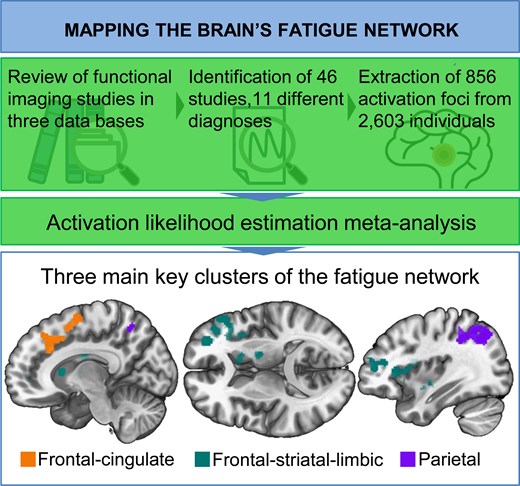Dolphin
Senior Member (Voting Rights)
Quite a lot of the studies looked at are ME/CFS studies.
Journal Article Accepted manuscript
Author Notes
Brain Communications, fcaf315, https://doi.org/10.1093/braincomms/fcaf315
Published:
28 August 2025
Article history
To identify a transdiagnostic functional network associated with fatigue, we conducted an activation likelihood estimation meta-analysis of neuroimaging studies. The primary inclusion criterion was studies involving any medical condition where patients exhibited significantly higher levels of fatigue compared to healthy controls. A systematic literature review across three major scientific databases identified 46 eligible neuroimaging studies, including a total of 2,603 individuals.
The meta-analysis of these studies revealed a widespread cortical-subcortical network involving frontal, limbic, basal ganglia, and parietal structures. Three main clusters were highlighted: a frontal-striatal-limbic cluster, a frontal-cingulate cluster, and a parietal cluster, with regions implicated in cognitive, emotional, and somatosensory symptoms associated with mental fatigue. Quality analysis indicated a moderate risk of bias in the majority of the included studies.
Overall, our findings provide scientific evidence for a transdiagnostic mental fatigue network in the brain, with key nodes located in the lateral frontal cortex, cingulate cortex, insula, thalamus, precuneus, and caudate. These results support the theory of thalamic-striatal-cortical dysfunction, which may impair compensatory mechanisms related to mental fatigue. Additionally, abnormal activation of limbic and parietal regions may contribute to cognitive, emotional, and attentional impairments linked to fatigue.

Graphical Abstract
Open in new tabDownload slide
Journal Article Accepted manuscript
Mapping the brain’s fatigue network: a transdiagnostic systematic review and meta-analysis on functional correlates of mental fatigue
Andy Schumann , Monica Di Giuliano , Steffen Schulz , Feliberto de la Cruz , Teresa Kreuder , Georg Seifert , Karl-Jürgen BärAuthor Notes
Brain Communications, fcaf315, https://doi.org/10.1093/braincomms/fcaf315
Published:
28 August 2025
Article history
Abstract
Mental fatigue is a significant psychopathological symptom that has recently gained attention, particularly in chronic fatigue syndrome/myalgic encephalomyelitis and Post COVID-19 condition. However, fatigue is a clinically relevant symptom across a wide range of mental and neurological disorders.To identify a transdiagnostic functional network associated with fatigue, we conducted an activation likelihood estimation meta-analysis of neuroimaging studies. The primary inclusion criterion was studies involving any medical condition where patients exhibited significantly higher levels of fatigue compared to healthy controls. A systematic literature review across three major scientific databases identified 46 eligible neuroimaging studies, including a total of 2,603 individuals.
The meta-analysis of these studies revealed a widespread cortical-subcortical network involving frontal, limbic, basal ganglia, and parietal structures. Three main clusters were highlighted: a frontal-striatal-limbic cluster, a frontal-cingulate cluster, and a parietal cluster, with regions implicated in cognitive, emotional, and somatosensory symptoms associated with mental fatigue. Quality analysis indicated a moderate risk of bias in the majority of the included studies.
Overall, our findings provide scientific evidence for a transdiagnostic mental fatigue network in the brain, with key nodes located in the lateral frontal cortex, cingulate cortex, insula, thalamus, precuneus, and caudate. These results support the theory of thalamic-striatal-cortical dysfunction, which may impair compensatory mechanisms related to mental fatigue. Additionally, abnormal activation of limbic and parietal regions may contribute to cognitive, emotional, and attentional impairments linked to fatigue.

Graphical Abstract
Open in new tabDownload slide
